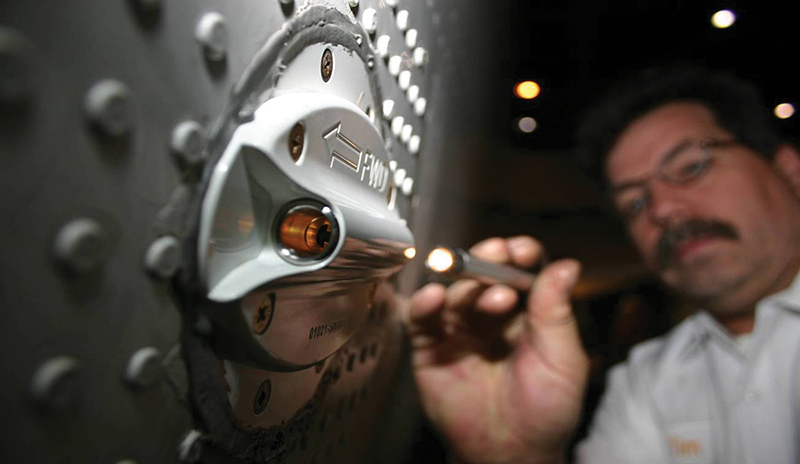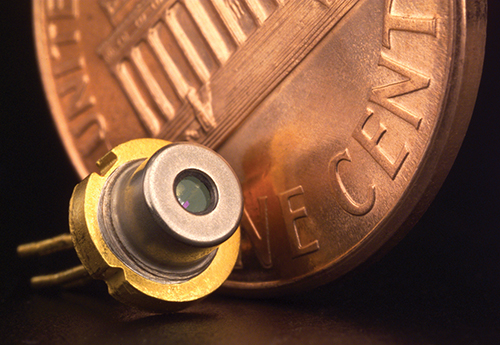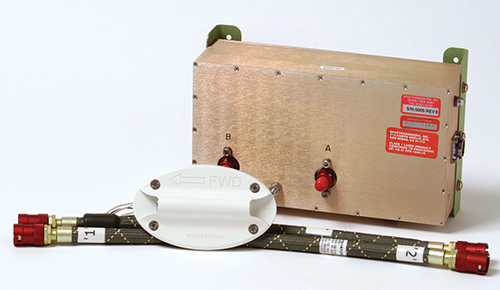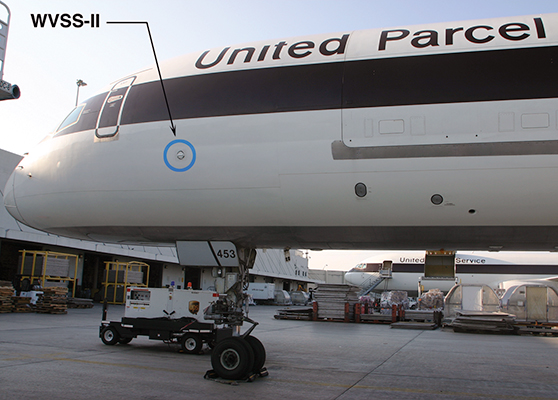
Water Vapor Sensors Go Sky-High to Assure Aircraft Safety
Originating Technology/NASA Contribution
A laser diode is a semiconductor-based laser used to generate analog signals or digital pulses for transmission through optical fibers or through open air. In simpler terms, it is the type of laser that scans the barcode of a product to determine its price or reads the information stored on a compact disc to play music.
While laser diodes make for great sensors in detecting product prices and playing music, they are also very good at detecting gasses. NASA’s Jet Propulsion Laboratory (JPL) developed a special type of laser diode-based gas analyzer that the Space Agency could use to measure atmospheric gasses on Earth and Mars.
In doing so, JPL used a special tunable diode laser, which NASA scientists could tune to different wavelengths—like a radio being tuned to different frequencies—to accurately target specific molecules and detect small traces of gas. This tunable diode laser was designed to emit near-infrared light at wavelengths absorbed by the gas or gasses being detected. The light energy being absorbed by the target gas is related to the molecules present. This is usually measured in parts per million or parts per billion. Multiple measurements are made every second, making the system quick to respond to variations in the target gas.
NASA scientists developed this technology as part of the 1999 Mars Polar Lander mission to explore the possibility of life-giving elements on Mars. NASA has since used the tunable diode laser-based gas sensor on aircraft and on balloons to successfully study weather and climate, global warming, emissions from aircraft, and numerous other areas where chemical gas analysis is needed.
SpectraSensors, Inc., was formed in 1999 as a spinoff company of JPL, to commercialize tunable diode laser- based analyzers for industrial gas-sensing applications (Spinoff 2000). Now, the San Dimas, California-based firm has come back to the market with a new product featuring the NASA-developed instrument for atmospheric monitoring. This instrument is now helping aircraft avoid hazardous weather conditions and enabling the National Weather Service to provide more accurate weather forecasts.
Partnership
Prior to co-founding SpectraSensors, Dr. Randy May spent 15 years at JPL, where he led several major research tasks related to the development and utilization of tunable diode lasers in gas sensors for atmospheric studies. Additionally, May oversaw a laboratory program that developed spectroscopic analysis techniques and algorithms for the manipulation and interpretation of molecular gas spectra.
After many years of successful instrumentation development for atmospheric studies on Earth, May and his JPL research team received NASA funding in the mid-1990s to further develop and miniaturize the technology for planetary and space station studies, where overall size, mass, and power consumption are critical. They first responded by designing and building two onboard diode laser gas-measurement systems for the Mars Polar Lander. The intention of these two systems was to give the spacecraft the ability to determine water vapor and carbon dioxide levels in the Martian atmosphere and in gasses evolved from heated soil samples.
The refinements made by May and his team prevailed in other realms of planetary research. They also provided NASA with an improved means of atmospheric measurement pertaining to ozone layers and a better understanding of weather/climate and aircraft emissions. All of these strides led to more applications for the sensors and made it feasible for NASA to consider their use in industrial monitoring and commercial aviation applications.
Soon after this realization, May—along with Dr. Carl Kukkonen—co-founded SpectraSensors to commercialize the tunable diode laser instrument for the industrial-process and environmental-monitoring markets.
Armed with proprietary technology and 15 years of NASA-related research experience, SpectraSensors moved into the marketplace with a laser device poised to revolutionize the way gasses are detected and monitored.
Product Outcome
SpectraSensors’ latest product, the WVSS-II (Water Vapor Sensing System-II), combines the NASA-developed tunable diode laser analyzer with an air-sampling device the company licensed from the University Corporation for Atmospheric Research (UCAR) to deliver real-time weather forecasting and help aircraft avoid dangerous weather conditions. Water vapor measurement is key to accurate weather modeling and forecasting, because of water vapor’s role in spawning unexpected turbulence, wind shear, fog, and thunderstorms. (When water vapor condenses, heat escapes through rising columns of air that create sudden instability in the atmosphere.)
Water vapor measurement, however, has long been the meteorologist’s missing forecast element. Wind and temperature measurements are routinely made for weather forecasting, but water vapor measurement does not occur as regularly. The conventional method for collecting water vapor data is to use an older type of sensor that employs a thin film capacitor. According to SpectraSensors, National Oceanic and Atmospheric Administration weather balloons equipped with these sensors are launched only twice daily to measure water vapor, at less than 100 sites in the United States. The problem with this method is that, in only a couple of hours, sudden atmospheric instability induced by water vapor can make the data collected by these balloons unusable.
Painting a picture of just how prominent water vapor is in the skies is UCAR scientist Rex Fleming: “In
a typical year, more water in the form of vapor and clouds flows over the dry state of Arizona than flows down the Mississippi River; yet we have not had a sensing system to collect accurate water vapor data frequently enough to be really useful for forecasts.” He added: “Commercial aircraft can fill a critical gap in atmospheric observations by gathering accurate data throughout the global atmosphere.”
The WVSS-II can fill this gap by providing water vapor information every 2 seconds when applied to a commercial aircraft. This continuous stream of data can fill that hole in the meteorologist’s forecast, plus help pilots to reroute around severe weather in real time. SpectraSensors noted that just 25 WVSS-II-equipped aircraft can supply more than 100 times the number of measurements made by weather balloons and satellites, all at a fraction of the cost.
The instrument’s air-sampling device was built to be mounted onto the side of a plane. This air-sampler channels air into a measurement cell that is housed in a casing the size of a cigar box and located on the inside of the aircraft. The sampler gives a true air reading by weeding out rain, ice crystals, particles, air contaminants, and any other distractions that might otherwise compromise an accurate measurement.
When a true water vapor sample is collected, it is analyzed onboard the plane by the tunable diode laser system, which contains the advanced control electronics and data-processing software specifically designed for this application. The results of the analysis can then be transmitted to entities on the ground, which can then disseminate it to passenger and freight carriers, and to government agencies for short- and long-range weather planning.
Since the laser sensor is housed inside the plane, it does not come into direct contact with the outside elements. This noncontact feature prevents the laser from becoming contaminated and, thus, gives it a longer operating life. Moreover, the WVSS-II coexists with traditional aircraft data streams, such as engine performance and fuel level, so fewer customized modifications are necessary.
The WVSS-II was certified by the Federal Aviation Administration for commercial aircraft flights in December 2004. Installation of the first 25 units took place on Boeing 757 aircraft flown by the United Parcel Service (UPS), which has been responsible for providing wind and temperature data to meteorologists since 1994. Now, with the WVSS-II, UPS is adding another dimension to its weather forecasts.
In addition, Southwest Airlines is planning to incorporate it in the near future. On an international scale, Lufthansa Airlines is installing the unit on its commercial aircraft, and the German Weather Service is in the process of certifying it for use, in collaboration with Australia, South Africa, and New Zealand.
A secondary function of the WVSS-II will be to calculate water vapor levels at extremely high altitudes to better understand global warming and the highly debated role that cirrus clouds play in this phenomenon. High, thin cirrus clouds tend to act as insulators, trapping heat before it can radiate into space. In many scientific circles, it is believed that this heat contributes to global warming.
Water vapor is a major factor in the rising global temperatures. It is the greenhouse gas that contributes more to the greenhouse effect than any other natural gasses in the greenhouse family. Water vapor levels in the upper troposphere and stratosphere are as low as a few parts per million, and traditional measurement techniques are not adequate to provide accurate, timely data, according to SpectraSensors. In the long term, the company sees its WVSS-II technology helping to address many unanswered questions related to the causes and effects of global warming.
In fulfilling the Vision for Space Exploration, NASA plans to use the sensors aboard space vehicles to measure water vapor and carbon dioxide in the soil and atmosphere of other planets. These measurements could provide information on the geological history of these planets and their potential to support life.

Miniaturized tunable diode laser packaging for sensing and measuring atmospheric water vapor.

SpectraSensor, Inc.’s WVSS-II (Water Vapor Sensing System-II) helps pilots reroute around bad weather, increasing public safety and saving money for airlines. The technology consists of an electronics box, an air sampler on a filler plate, and connection hoses.

“In a typical year, more water in the form of vapor and clouds flows over the dry state of Arizona than flows down the Mississippi River,” said Rex Fleming, a scientist with the University Corporation for Atmospheric Research.

The United Parcel Service, which provides wind and temperature data to meteorologists, is now flying the technology on its aircraft, for increased reliability of forecasts.

The air-sampling device was built to be mounted onto the side of a plane. Its aerodynamic design removes ice crystals, particles, rain, and other distractions to improve the sensitivity of the air measurement.













